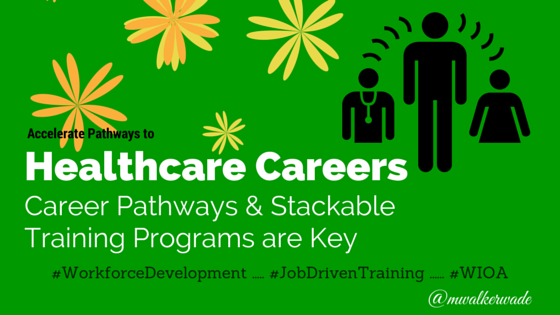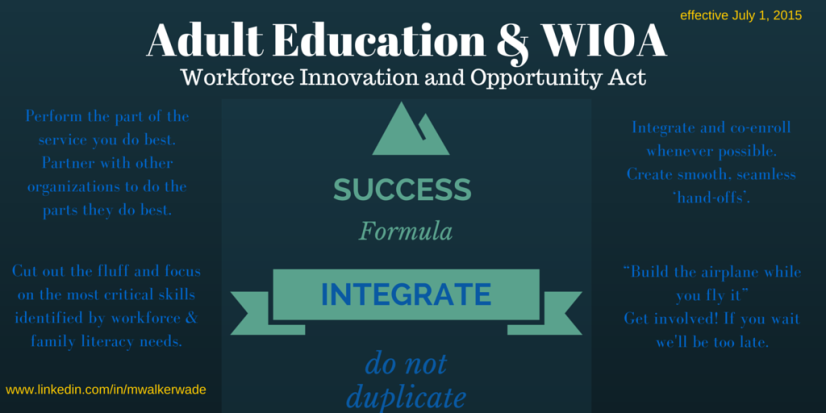Archive
Creating Accelerated Career Pathways into Healthcare
 According to Manpower’s 2015 Talent Shortage Survey (#TalentShortage), nursing occupations is #7 on a list of 10 industries. For survey purposes, nurses includes:
According to Manpower’s 2015 Talent Shortage Survey (#TalentShortage), nursing occupations is #7 on a list of 10 industries. For survey purposes, nurses includes:
Non-degree: CMAs, PCAs, CNAs, HHAs, LPNs, and LVNs
Degreed: RNs
Advanced degree: APNs, NPs, PAs, CLNs, CNSs, CNMs, CRNAs
According to Stephanie Neuvirth, chief human resources and diversity officer at City of Hope in Duarte, CA:
“Jobs in accounting, finance, IT and administration are plentiful in health care. Although these jobs provide the infrastructure for the health care industry, parents, guidance counselors and students don’t realize they exist.”
Career fields such as healthcare, especially where patient contact is key, are challenging to fill because success depends on having the right combination of soft skills, technical skills, and physical ability. Certain roles in health care also needs individuals who are able to relate to the cultural and spiritual norms of the patient. Healthcare providers in Duarte, CA understand this challenge all too well, as 71% of their patients are Hispanic.
“Only 6 percent of the physicians and 8 percent of the nurses in the U.S. are Hispanic”
When I look across the landscape of career education, I see many schools providing training in allied healthcare, yet employers still struggle to get the type of employee they really need. It’s clear that the typical training program is not quite hitting the mark. In some cases the problem is the curriculum, in other cases the problem is access to internships, but in some cases (and I hate to say this) it’s the student. I’ve had first-hand experience on numerous occasions where a student wanted to join my healthcare training program because “there’s a lot of jobs in healthcare”. As a program manager, if your primary concern was getting enough students enrolled into the course to meet your revenue target, it may be easy to fill your class with students who can do the technical skills of medical care, but who lack the genuine compassion for patient care. These type of students will ultimately be fairly unemployable in the healthcare industry. As workforce development planners and education & training providers I believe this is something that deserves our consideration.
There are three programs making an impact on suring-up our need for qualified and quality health care talent I’d like to share with you:
CareerSTAT is “an initiative to document and endorse the business case for investments in frontline hospital workers and to establish an employer-led advocacy council to promote investments that yield strong skill development and career outcomes for low-wage, frontline hospital workers”. Nearly 100 health care organizations partner with CareerSTAT including Kaiser Permanente and Banner Health. Some of their activities include:
- An employer-led national collaboration of health care leaders
- A clearinghouse for best practices in health care and shared information in training development
- A focus on early college and career pathway programs and provides low-income and minority students with access to in-demand health care careers
- Work towards initiatives that would get Hispanic youth engaged in health care careers
TEACH Project (Train, Educate, and Accelerate Careers in Healthcare)- seeks to create skilled workers in health IT. This project works with high-school students to provide education, training and job shadowing opportunities, integrated with their current school studies. Students concurrently receive high-school credit, community college credit, and on the job experience that accelerates their entrance into a job in the medical field.
Homebridge, Inc in San Mateo, CA – One of the most advanced employer-based, entry-level training programs into the medical field. The Homebridge training program provides adult-centered, competency- based training curriculum, designed to be accessible to students with a minimum of 6th grade proficiency. The training highlights the value of hands-on learning and includes a simulation apartment where caregivers can practice with beds, wheelchairs, and bathroom facilities. Success in the classroom is supported in the field by peer mentors who provide on- the-job training and a work-life coach who addresses barriers to job retention. Because of their strong emphasis on training & development, Homebridge’s 37% turnover rate for frontline caregivers is 31% lower than the 54% national average.
As workforce developers and education & training providers move forward with WIOA (Workforce Innovation & Opportunity Act) implementation activities, I believe programs like these give great models to emulate, but more so, some good starting points for finding the right kind of partnerships. Remember, partnerships and “stackablity” are key components to a successful WIOA funded program.
This article is based on my own research, therefore I have no endorsement of any kind from these three programs. If you’d like to read more about them you’ll find articles at these two links.
CareerSTAT & TEACH – http://tinyurl.com/p8vjymn
Homebridge, Inc: http://tinyurl.com/o88rjsf
Adult Literacy Education Providers Prep for WIOA’s Integrated Education and Training pt 2
THE WIA-TO-WIOA TRANSITION BEGINS JULY 1, 2015
THE UPCOMING ACADEMIC YEAR IS A YEAR OF CHANGE
In 2012 the U.S. Department of Education Office of Vocational and Adult Education produced a 30-page document titled: Promoting College and Career Readiness: Bridge Programs for Low-Skill Adults. If you read through it, you will see very sharp resemblances of what we as Education & Training professionals should be focusing on to gear up for WIOA changes on our campuses and in our classrooms. Some of the terms in the report vary from the terms in the WIOA proposal, but the meanings are the same.
♦♦♦ I will highlight some of the report’s content below ♦♦♦
Create bridge programs (“Pathways”) to help adult students identify career and education goals and develop the skills, content knowledge, and learning strategies needed to enter and succeed in postsecondary education and employment.
Combine (“Integrate”) basic skill instruction in reading, math, writing, and English language, including preparation for the GED test, employment skills, and college success strategies. Some bridge programs also offer college credit and certificates (“Nationally recognized credentials”), which may be the first step toward a college degree.
Use state and local labor market information develop bridge programs focused on occupations or industry sectors with a high demand for employees. ♦ Note: Your local Workforce Investment Board will need to be very involved in your education and training program planning, per WIOA.
For examples of what your education and training programs should emulate, consider these:
- Washington’s I-BEST approach: an integrated ABE (and now ELA) and CTE instructional planning process and co-teaching.
- Oregon Pathways for Adult Basic Skills Transition to Education and Work Initiative (OPABS) provided the impetus for the state’s Adult Basic Skills (ABS) system to incorporate career pathways and assist in transitioning learners into further education and employment, including formal connections to postsecondary education and OneStop Career Centers.
- (Alabama Community College has also gained recognition for being fairly “WIOA Ready’ and therefore also serve as a great example for planning and implementation.)
Finally…
Look to form partnerships with organizations such as these:
Jobs for the Future (JFF) Breaking Through and ABE to Credentials initiatives
The Joyce Foundation Shifting Gears initiative
The Nellie Mae Education Foundation New England ABE-to-College Transition project
The time to get involved and to start your transitional planning is now.
Sources:
http://www2.ed.gov/about/offices/list/ovae/pi/cclo/brief-1-bridge-programs.pdf
Adult Literacy Education Providers Prep for WIOA’s Integrated Education and Training pt 1
 In her article “What you need to know: Workforce Innovation and Opportunity Act (WIOA)” Melinda Mack, Executive Director, New York Association of Training & Employment Professionals says:
In her article “What you need to know: Workforce Innovation and Opportunity Act (WIOA)” Melinda Mack, Executive Director, New York Association of Training & Employment Professionals says:
WIOA’s Intention for Literacy is to “deepen connection between Title I and Title II, through nimble career pathways and vocationally focused literacy (most common example is the I-Best model out of Washington State)‘; including serving low-basic skilled”
These career pathways must be in high-skill, high-wage job industries. Adult Education providers should already be looking for the best ways to fulfill this requirement. The high-skill/high-wage jobs may vary from one area to the next; but, the most typical industries will be healthcare, Computer Science/ Computer Network Technology, Accounting, and Manufacturing Technology. According to ManPower Group, The 10 Hardest Jobs To Fill In 2014 are:
- Skilled Trade Workers
- Restaurant and Hotel Staff
- Sales Representatives
- Teachers
- Drivers
- Accounting and Finance Staff
- Laborers
- IT Staff
- Engineers
- Nurses (see infographic: http://www.manpowergroup.us/campaigns/talent-shortage-2014/assets/pdf/MPG_US_TalentShortagVertInfogrphcFINAL.pdf)
I’m pretty sure career pathways in these industries would satisfy WIOA’s intentions for integrated, job-driven training. Adult education providers should check with your local Workforce Investment Board (WIB) for education and training needs for your region. The WIB produces reports showing which industries in your area are growing, shrinking, and are expected to remain flat. WIOA will also require education providers and local WIBs to work more closely together; so, this information should be pretty easy to obtain. For literacy-level programs, we’ll just need to get students moving along the pathway towards particular industry and help prepare them for entry-level work in fields with great job growth potential. We’ll do this by providing “Integrated Education and Training” – the combining adult education and literacy activities concurrently and contextually with workforce preparation activities and workforce training for a specific occupation or occupational cluster for the purpose of educational and career advancement. Literacy education providers need curriculum that is suitable for this type of learning.
Please keep checking back for more information. We have quite a bit to do and learn before WIOA goes into effect.
Hats off to you!
WIOA!!! What’s Going to Happen to Low-Literacy Adults?
The current federally-funded adult education system reaches fewer than 6 percent of the 36 million adults with severe deficits in WORKFORCE literacy. Ready to Work: Job Driven Training and American Opportunity, the July 2014 White House study outlining future directions for career and college readiness through WIOA (Workforce Innovation and Opportunity Act), mandates more collaboration between Education and Labor and stronger business involvement (by sponsoring apprenticeship and other on-the-job training, including for services for “lower skilled” adults). Some of the changes necessary to remain a federally-funded adult education provider under WIOA will be a difficult transition for many providers and learners. I believe we’ll continue seeing program closures, as only the “strong” will survive.
Workforce literacy curriculum is generally out of reach for an alarmingly high number of adults whose reading skills are 4th grade a lower. For this population of learners we’ll most likely see an increase in community-based, volunteer-driven organizations become the major service providers of low-literacy adults for whom getting a job or going to college is not their goal.
The issues with literacy as it pertains to basic skills and workforce readiness only make an impact in the political and other legislative circles when the problems created by it weakens our economy. As long as the illiterate can be “contained” or “controlled” (and I use those terms with no disrespect to the citizens at large) with government subsidized programs, illiteracy can remain a low priority. However, because “the powers that be” are beginning to realize the long-term economic impact illiteracy is having on our skilled workforce, it has become a major priority. We have yet to see to what level of illiteracy will the funding flow.
What kind of alternatives will it create for the 50 year-old native English speaker who can only read at a 1st or 2nd grade-level? Or for the 40-year old non-native English speaker who was an Accountant in his/her home country? Believe it or not there are MANY adults working in American factories who cannot read or write. I had many adults go through my training program who had been laid off of their factory jobs after 30 years of US employment. Some were totally illiterate even in their own native language. Most could not read even at 3rd grade level. Many could not speak nor understand spoken English.
We’re already seeing libraries picking up the slack in low-literacy instruction; but it will be interesting how they handle the coming capacity. Library literacy programs have been around for decades and they continue finding new ways to meet community needs such as adult literacy. In California, the State legislated library-based adult literacy programs 30 years ago; but I do not believe we’ll see a shift in federal funding for it. There are also many community development corporations providing literacy-based education as well. These organizations depend on volunteers to maintain their literacy programs; but, as one agency’s Volunteer Coordinator says: “it will be hard to have enough long-term volunteers as finding volunteers who want to commit for a long time is already challenging…”
How can organizations prepare for the growing dilemma? Here are a few suggestions:
Increase Partnerships and Service Locations
- Partner with local churches and/or religious assembly. Ask them to make adult literacy a part of their regular Religious Education programming, offering literacy at the same time and location as their other “study” meetings. Get volunteers from these organizations to teach/tutor the learners.
- Partner with local Family Literacy programs; think of a way to effectively combine k-5 homework clubs with literacy help for their parents.
Leverage Use of Technology
- Spend time now teaching higher-level literacy students more digital literacy and collaborative learning skills. Transition cohorts of students into learning quads that use eLearning and collaboration for 75% – 80% of their instruction, and a live teacher/trainer for the remaining 20-25%.
- Beef-up your distance learning program and curriculum. Build in more expectations and accountability measures for participants.
I know it will be tough getting learners and educators to think differently about these changes. Plain and simple, instructional delivery will be different. As these restrictions play themselves out everyone will have to accept the inevitable. Acceptance is the first step to empowerment!
OCTAE’s Brief Report on “Making Skills Everyone’s Business”
I came across this brief report from OCTAE (Making Skills Everyone’s Business – A Call To Transform Adult Learning in the United States) and wanted to share it with you. The full report will publish in August 2014. I’ve noted the points in this article that stick out most to me below. As you’ll see, some of these points definitely need further thought and development. I hope you find it an interesting read!
- The current federally funded adult education system reaches fewer than 2 million adults annually; but, estimates show there are 3 million adults ready to start improving their skills now and 36 million more adults who could benefit from it.
- Improving adult skills increases productivity and, among industrialized nations, countries with higher cognitive skills have substantially higher long-term economic growth.
- The promoting of career pathways is “an efficient and customer-centered approach to training and education …” This holistic practice utilizes contextualized instruction, a model found to be effective with low-skilled adult learners.
- The current adult education system lacks the infrastructure to support teachers equitably across states and programs. Greater investments are required for high-quality professional development.
- Almost two-thirds of the low-skilled population in the United States is employed. They are remarkably diverse in terms of learning backgrounds, earlier achievement gaps, and current literacy & language skills. We must also consider low-skilled adults with disabilities and chronic health issues
- Federal tax and federal-share incentives, such as incumbent worker training, on-the-job training, apprenticeships, unemployment insurance, work sharing, and more closely coordinated training programs, can be used to increase the foundation and technical skills of entry-level employees and new hires.
Make Short and Long-term Goals for your Career and Financial success
Make short and long-term goals for your career and financial success.
 Plan for your work-based success, current and future financial provision, professional growth, and social influence. Set goals, plan for them, prepare to do well, and start taking steps needed to reach them!
Plan for your work-based success, current and future financial provision, professional growth, and social influence. Set goals, plan for them, prepare to do well, and start taking steps needed to reach them!
Goals don’t come to you, YOU go to them!
There are so many free and low-cost options available online to help you obtain the knowledge and develop the skills needed to obtain your career and financial goals. Resources like:
- http://www.lynda.com —- Low Cost
- http://www.skillshare.com —- Low Cost
- http://www.coursera.com —- FREE
- and more!
If your current job will not provide for your personal and career goals, you must make a conscious decision to sacrifice certain comforts now so you can live well in the near future. So get ready to sacrifice.
In creating your goals, make sure they are are SMART!
A SMART Goal must be:
- Specific
- Measurable
- Agreed, achievable, applicable
- Realistic & relevant
This YouTube video explains it well.
I want to see you succeed! I want to see you climb up from where you are now, and excel to an awesome place in your future. Are you ready and willing?
Go Ask Michelle Q & A: Medical Assisting Training of Unitek vs. Boston Reed
I’m interested in the clinical medical courses you offer, an am curious on what it entails.Is the program accredited? How different is this 3 month program v.s. a 9 month program (for example at Unitech)? Does the program offer job-placing after completion?
MICHELLE’S ANSWER
Just looking at Unitek’s program, here are the immediate differences I see:
Unitek’s Medical Assisting teaches both administrative and clinical procedures, NHAS via Boston Reed’s Clinical Medical Assisting only covers clinical procedures.
Unitek’s program most likely is primarily in-class instruction, whereas NHAS via Boston Reed’s program is blended learning with approximately 40% of instruction being delivered online, and 60% in-class. Both are accredited programs.
Unitek appears to have an employment assistance program, but I would suggest you asked them some really tough questions about what all it includes and what the counselors do to help you find employment. Boston Reed helps place students who pass the class at 80% or higher into internships. I’m not sure what other assistance is available after that, but again, when before signing up with them you should ask the same hard questions.
Whether you go with Unitek or Boston Reed you may find that your clinical and internships can be up to an hours drive from the school location. So flexibility is important.
My final suggestion is this: if you want something more comprehensive than what we offer, before you shell out the higher cost of a Unitek class, check out Castro Valley Adult & Career Education. They have a comprehensive Clinical Medical and Administrative Medical program that will save you lots of money.
5 Top Resume Suggestions Made to Job-Seekers
On June 28th I participated in the Northern California Silicon Valley Career Strategies Forum event as a résumé reviewer; we had over 200 job-seekers in attendance. After reviewing many résumés that day, I want to share with you the top five résumé suggestions I made to various attendees.
You can take a look at my youtube video to hear the details, and I will also list them briefly below.
FIVE Top Suggestions in a Nutshell
- Don’t try to make one résumé fit all jobs.
- Make sure you use the first page of your résumé most effectively.
- Let go of the objective statement, and use a career profile or a summary of qualifications instead.
- Be more compelling in describing work experience .
- Format your text so it is easy for the reader to view; this pertains to font sizes, line spaces, margin size, etc.
I hope you take time to watch the video. I believe you will find the information to be useful. Feel free to ask questions or leave feedback below.
~ Blessings!
Twitter: @mwalkerwade
FaceBook: http://www.facebook.com/mwalkerwade
Blog: https://workplacelit4adults.wordpress.com
YouTube: http://www.youtube.com/WorkplaceLit4Adults
What Can I Do With That Degree?
We have built up the idea of getting a college degree as the complete key to success; yet, we clearly see that simply having a great education and an earned degree isn’t enough to keep you from being an unemployed (or under employed) job-seeker. Vocational colleges, on the other hand, have tooted their horn that students can quickly get in, get the skills needed for a particular career, and get to work.
I’m an advocate of education, and my particular area of interest is career education, having over 12 years of experience in this field. I talk to many adults trying to make decisions about their career, who are in transition, and who wonder should they go back to college for a 4-year degree, or go to a vocational institution and get a new job skill. There is no one right answer. Determining which way to go, and WHEN to take which move first requires a series conversations, soul searching, and personal research. The money and time you are getting ready to invest in “re-tooling” yourself should not be a quick, brash decision. As an adult learner with adult life responsibilities you must critically listen to college and career institution recruiters, and then do your own research. You should take time to find the answers for yourself to questions like:
- What can I REALLY do with that degree?
- Will that degree be enough, or will I need an advanced or accompanying degree to land a good job?
- How plenteous are the jobs in this field in my geographical area?
- What companies in my area look for people with my degree and or skill?
- Will my degree be enough, or will the employer want me to have other skills as well?
- What is the future of my industry of choice?
- Will the jobs I see now still be the same when I’ve finished my studies?
These questions can be daunting, time-consuming, and if not approached with the right attitude, could make a person less motivated to persist. But, trust me, and the thousands of degreed job-seekers whose student loan payments are eating them alive, getting the strategy upfront is much better than dealing with the crisis afterwards.
My opening question was: What can I do with that degree? Not looking at degrees such as Business, Marketing, Education, and other job-focused degrees, I want to give you a few resources to check out. The information here is just enough to give you some ideas, but it is in no way enough to say you’ve done your research. Take a look, and leave some feedback if you will.
DEGREE PROGRAMS
If you have any insight on the following degrees (undergraduate level preferred) please do share.
~ Blessings to you!
This is Not Your Ole’ School Manufacturing Job – CNC Skills Required!
I’m hearing lots of chit-chatter about bringing manufacturing jobs back to the United States so we can get Americans working again. I’m all for it and believe it is the right move to make. However, my friends, let’s not convince ourselves that we’re ready to waltz our way into these positions.
According to information explained in this article [U.S. manufacturing sees shortage of skilled factory workers], the United States has had a shortage of qualified manufacturing workers for quite some time. You can read the article in its entirety, but I want to highlight a few points from it so you can quickly see the challenges and opportunities facing our workforce.
- Our current losses have NOT left a surplus of skilled factory workers who have the skills needed for today’s manufacturing careers. On the contrary there are many factory workers who have lost their jobs because their manufacturing skills are out dated.
- The manufacturing industry does not have a shortage of workers who can run old-fashioned presses and lathes; but it does have a shortage of workers who can handle the new technology of the industry.
- Right now there are about 600,000 job openings in this industry, yet even with our record high unemployment rate the jobs remain open and unfulfillable. This industry needs employees with specialized technical skills who can program in the numeric code called CNC, which is a code that instructs the automated production machine precisely how to do the work. Check out this conversation between two industry professionals; you will see it sounds nothing like the conversations that used to take place between machinists.
- You can get the CNC skills needed by looking for training and/or degree programs in machine tool technology from a community college or vocational school. More ROPs should consider offering these courses to high schoolers as well. (see the listing below)
- Just because the machinist needs to be more skilled does not mean this job is no longer a “shop job”. Machinists will still work in noisy and somewhat unclean conditions wearing uniforms that get a little dirty, but these blue-collar workers will make approximately $4/hour more than their white-collar counterparts.
In closing, I’d like to take some words straight from the original article’s section called “New Recruiting Tactics”. It says:
“The shortage has forced firms to adopt new tactics. To fill slots, a few manufacturers have turned to hiring candidates who are untrained but have the inclination to work with their hands…. ‘We knew that we were not going to find the people with the right skills right off the streets,’ said Mark Pringle, director of operations at the plant. “So we tried to find people with the right aptitudes.’”
So, there you have it; all of you who look forward to the re-birth of manufacturing in the United States, we’ve got our work cut out for us. My recommendation to anyone remotely interested in getting into manufacturing is this: Don’t wait for the jobs to come back to your neighborhood before preparing for them. You are now informed of the challenges and opportunities ahead, so get in school and prepare now.
Here are a few schools and training centers in California that offer CNC coursework. If you know of any more, please let me know so I can add them to the list. You’ll need to brush up on those math (algebra), reading, and problem-solving skills to survive these courses.
| City | School/Training Center | Website |
| Anaheim | North Orange County ROP | www.nocrop.tec.ca.us |
| Fresno | Fresno City College – CNC Degree | www.scccd.com |
| Fullerton | Fullerton College | http://machine.fullcoll.edu |
| Glendale | Glendale Community College – CNC Degree | http://www.glendale.cc.ca.us |
| Hayward | Chabot Community College – Certificate in CNC Programming | www.clpccd.cc.ca.us |
| Los Angeles | Los Angeles Trade Technical College – AS in CNC | http://www.lattc.cc.ca.us/ |
| Modesto, CA | Modesto Junior College – Machine & Tool Tech | www.mjc.edu |
| Norwalk, CA | NTMA Training Center | http://trainingcenters.org |
| Ontario, CA | NTMA Training Center | http://trainingcenters.org |
| Reedley, CA | Reedley College – Manufacturing Technology Machine Shop | http://www.reedleycollege.edu/index.aspx?page=153 |
| Riverside, CA | Masters Vocational College | www.mastersvoc.com |
| San Bernardino | San Bernardino Valley College | ccentra.sbccd.cc.ca.us |
| San Jose | TTL College | http://www.ttl-school.com/courses.htm |
| San Jose | San Jose City College – Machine Technology (CNC) | www.sjcc.edu |
| San Jose | San Jose State University – Degree in http://www.engr.sjsu.edu/tech | www.engr.sjsu.edu/tech |
| Santa Ana | Santa Ana College – CNC degrees | www.sac.edu |
Before you go, check out this youtube video:
I hope this helps get you moving in the right direction. Blessings!
~ Michelle Walker-Wade








